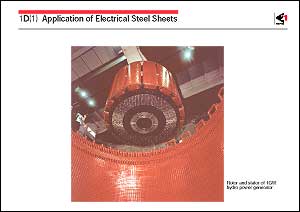Everyday life has been improved
immeasurably by the use of electricity which is produced by converting
hydro-, thermal- and nuclear-energy by generators in power plants.
The photograph shows the type of generator that is widely used
in hydroelectric power plant. Electrical steel sheets are used
in the iron core of the stator and rotor of the generators.
The interaction between electricity and magnetism is used in
such electrical equipment as generators, motors, and transformers.
Materials capable of efficiently enclosing magnetic flux (called
ferromagnetic materials and having high magnetic induction in
a magnetic field) are required in order to use this interaction
efficiently. The maximum value of magnetic flux density for a
material placed in the magnetic field is called the saturation
magnetization and is unique to the material. The elements that
show ferromagnetism at room temperature are iron, nickel and
cobalt, all being transition metals. Of these, iron has the highest
saturation magnetization of 2.15 tesla.
When a ferromagnetic material is subjected to magnetization by
an alternating current, energy losses called iron losses result.
Iron losses are of two kinds: hysteresis loss, which occurs due
to migration of the magnetic domains in iron, and eddy current
loss, which occurs when an eddy current is induced in iron by
an alternating current magnetic flux. Electrical steel sheets
are required to provide minimized iron losses in addition to
high saturation magnetization. Iron has high saturation magnetization
and a large eddy current loss due to its low electrical resistance.
In 1889, Hadfield of England discovered that the addition of
silicon to iron raised electrical resistance and reduced eddy
current loss. Minimizing the decline in saturation magnetization
by crystal orientation control and maximizing the electrical
resistance by the addition of silicon have been the key issues
for developing electrical steels. At present, 3% silicon steels
are most commonly used for high quality electrical steel sheets. |
|
 |
 |
 |
|
|